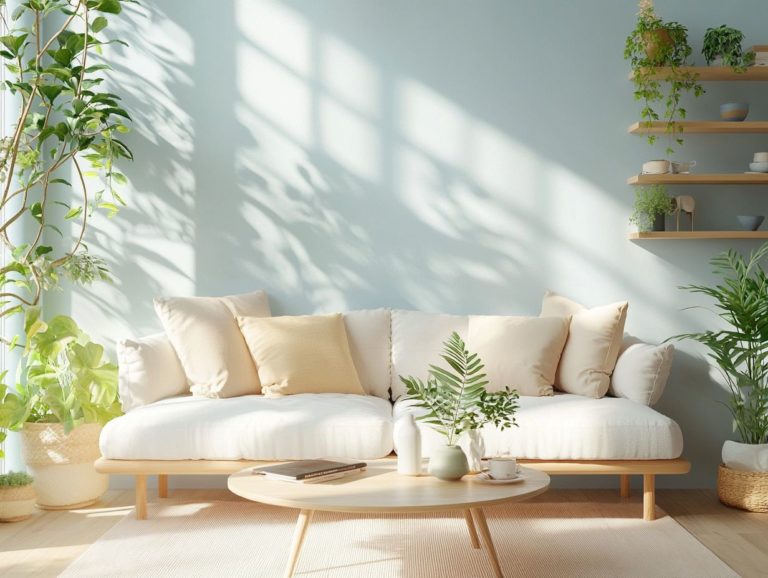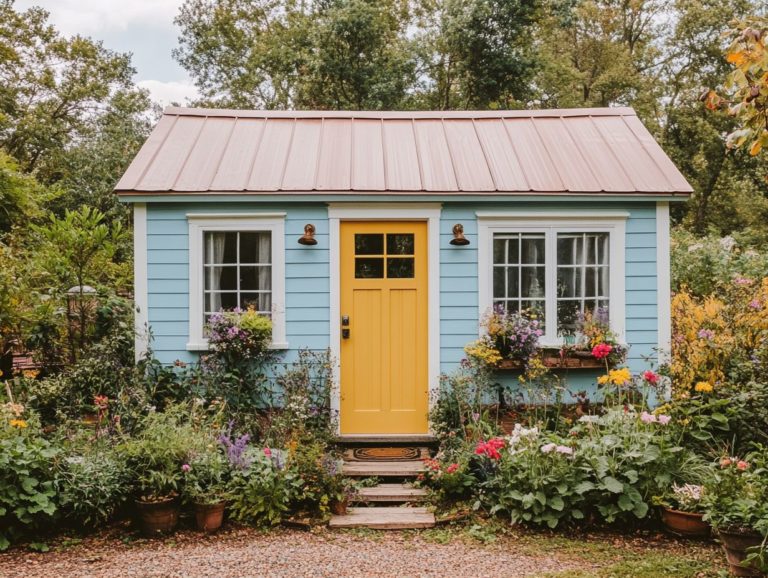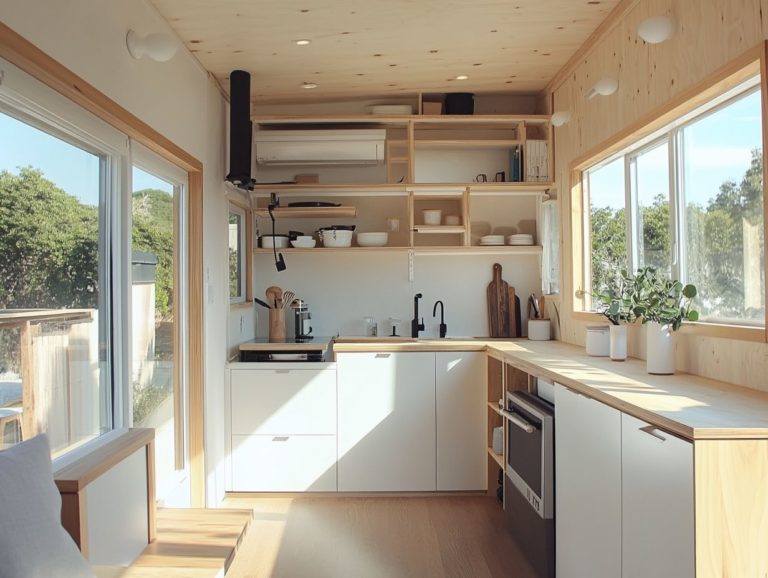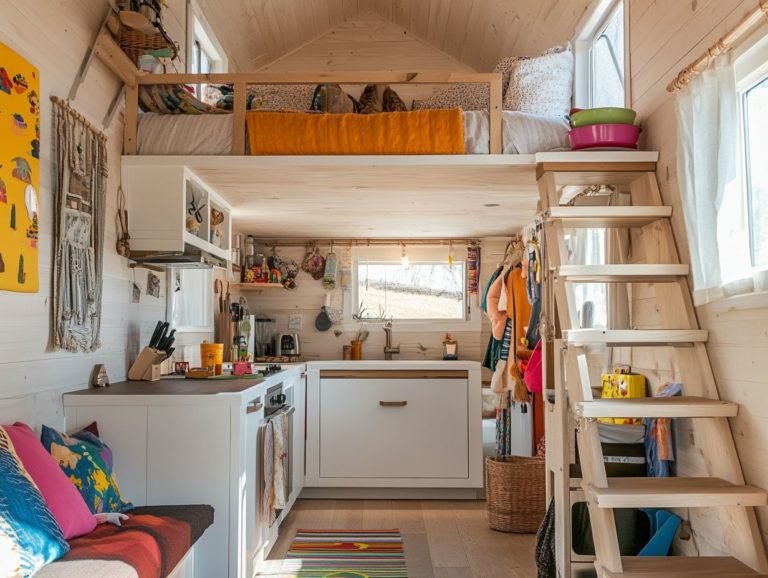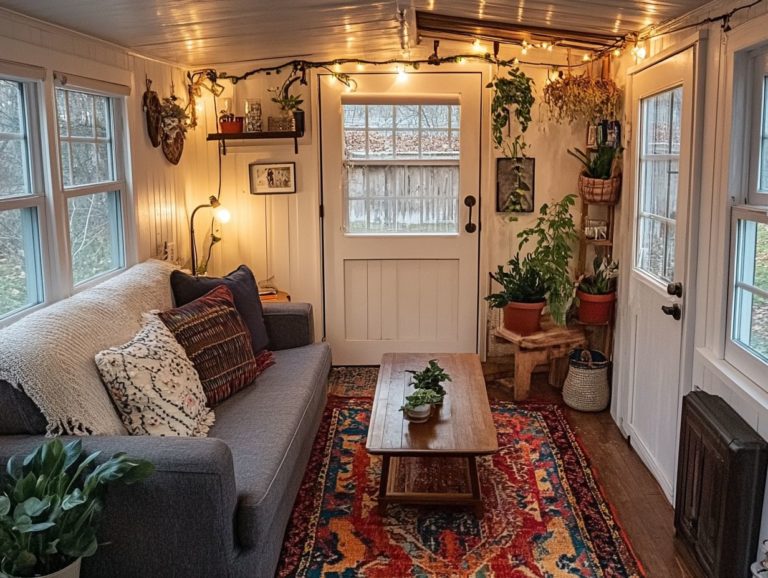Choosing Eco-Friendly Paint for Tiny House Interiors
In a world increasingly focused on sustainability, your choice of paint for your tiny house can truly make a significant impact. Traditional paints often contain harmful chemicals and hazardous air pollutants that can negatively affect both your health and the environment. Eco-friendly paints and sustainable options provide a safer, greener alternative, ideal for crafting a cozy yet stylish sanctuary.
This article explores the environmental repercussions of conventional paints, highlights the advantages of eco-friendly solutions, and offers practical tips for selecting and applying them all while ensuring your tiny home remains stunning and durable. Explore how you can make a positive difference with every brushstroke!
Contents
- Key Takeaways:
- Why Choose Eco-Friendly Paint?
- Types of Eco-Friendly Paint
- Considerations When Choosing Eco-Friendly Paint
- How to Apply Eco-Friendly Paint
- Maintaining Eco-Friendly Painted Surfaces
- Frequently Asked Questions
- What are some benefits of using eco-friendly paint for tiny house interiors?
- How do I know if a paint is truly eco-friendly?
- Can eco-friendly paint still provide good coverage and color options?
- Do eco-friendly paints cost more than traditional paints?
- Are there eco-friendly paint options for different types of surfaces?
- Can I still achieve a professional finish with eco-friendly paint?
Key Takeaways:
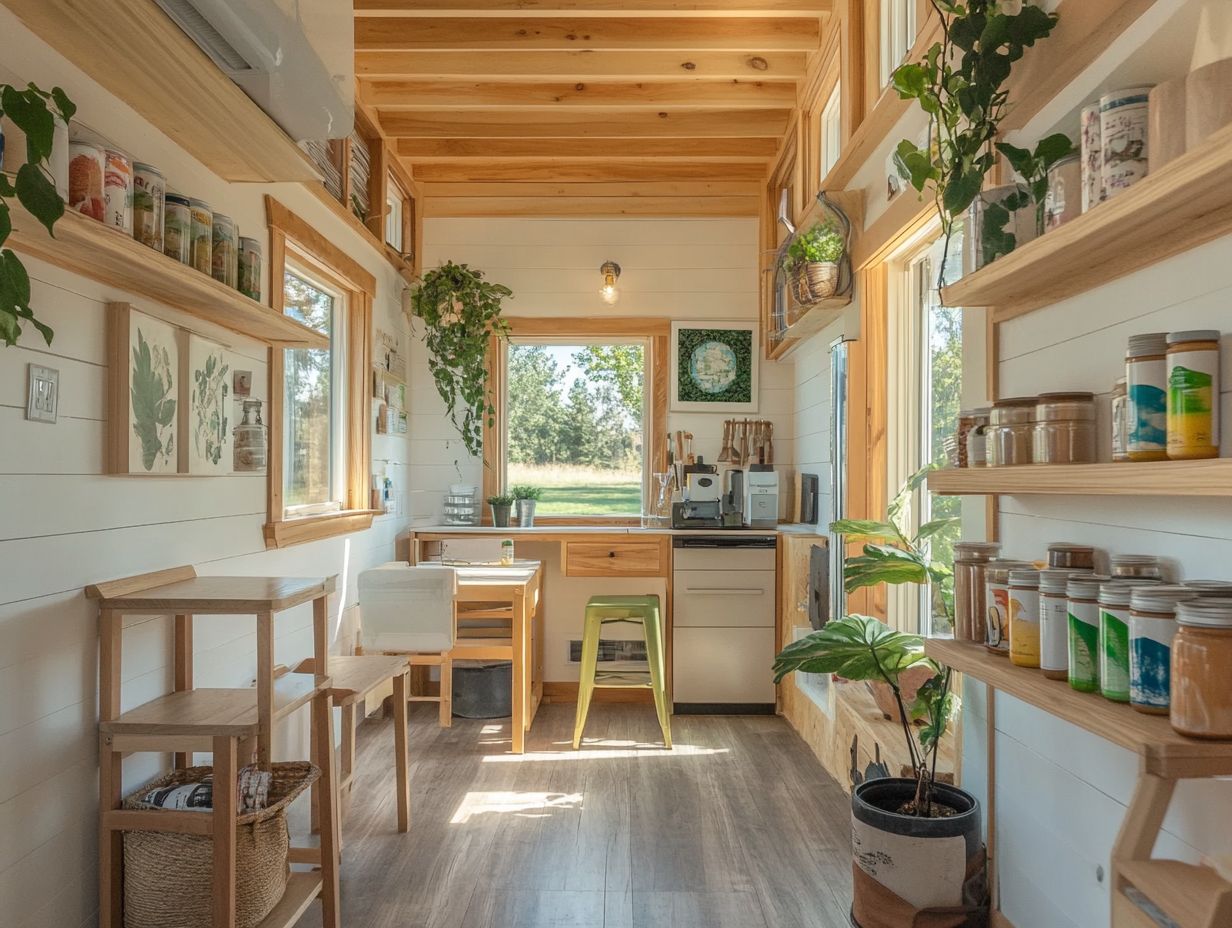
- Switching to eco-friendly paint can reduce your carbon footprint and contribute to a healthier environment.
- Natural and low/zero VOC paints are the most environmentally friendly options for tiny house interiors.
- When choosing eco-friendly paint, consider indoor air quality, durability, and safe production for long-lasting and easy maintenance.
Why Choose Eco-Friendly Paint?
Selecting eco-friendly paint is essential for anyone looking to enhance their living space while reducing their environmental impact. Transitioning from conventional paints, known for their harmful chemicals and high levels of volatile organic compounds (VOCs), to sustainable alternatives not only improves indoor air quality but also fosters a healthier home environment.
By choosing paints with low VOC or no VOC formulations, you can significantly lower the health risks associated with air pollution and embrace sustainable living practices. This choice reflects a commitment to eco-conscious values and responsible environmental decisions, ensuring your home is both beautiful and mindful of the planet.
The Environmental Impact of Traditional Paint
Traditional paints pose significant environmental concerns due to their high levels of harmful chemicals and hazardous air pollutants that can negatively impact both your health and the ecosystem.
These substances often include volatile organic compounds (VOCs), which can easily evaporate into the air and degrade air quality. When released, these emissions can lead to the formation of ground-level ozone, a key component of smog linked to respiratory issues like asthma and bronchitis. The Environmental Protection Agency (EPA) states that indoor air pollution largely worsened by these paints can be two to five times worse than outdoor levels, underscoring the need for better alternatives.
Studies show that prolonged exposure to VOCs can lead to headaches, dizziness, and long-term damage to vital organs like the liver and kidneys, or even the central nervous system. This highlights the urgent need for safer paint options that you can confidently choose for your home and health.
Benefits of Eco-Friendly Paint for Tiny Houses
Eco-friendly paints offer remarkable benefits for your tiny house, showcasing sustainable options that elevate both your living experience and environmental responsibility.
By minimizing harmful emissions and featuring fewer volatile organic compounds (VOCs), these paints significantly enhance indoor air quality crucial in compact spaces with limited air circulation. When selecting your paints, consider organic varieties, such as those from Benjamin Moore’s Natura line or the biodegradable options from ECOS Paints. Additionally, if you’re looking for sustainable solutions, check out this guide on eco-friendly flooring for tiny homes. These choices provide vibrant colors without compromising your health.
Not only do these selections shield you from harmful chemicals, but they also help create a more breathable atmosphere, promoting your well-being in a small home. Embracing eco-friendly paints can lead to healthier living environments and contribute to a greener planet. Additionally, choosing the right sustainable materials for your tiny home can further enhance your living space.
Types of Eco-Friendly Paint
You ll find a variety of eco-friendly paint options that cater to your unique preferences and needs. From natural paints to low or zero VOC and eco-friendly choices, these products support sustainable practices and contribute to healthier living environments.
Natural Paints
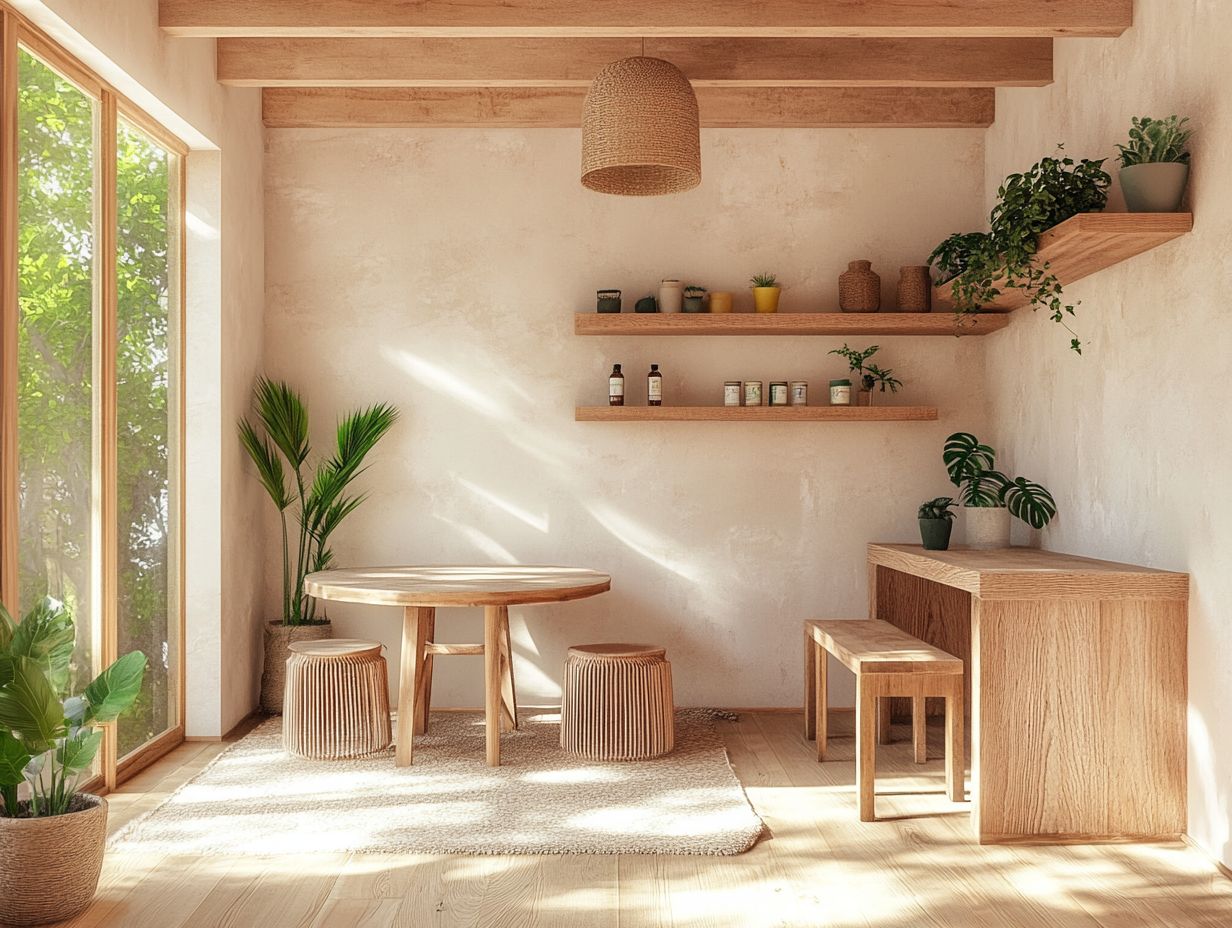
Natural paints are expertly crafted from organic pigments and materials, providing an environmentally friendly option that supports sustainable living without sacrificing quality or aesthetics.
These paints consist of ingredients like plant oils, resins, and natural waxes, ensuring they remain free from the harmful chemicals often found in conventional paints.
By opting for natural paints, you can significantly enhance indoor air quality, benefiting both your health and the environment.
Discover how natural paints can transform your home with a recent case study involving a renovation project in a family home. The homeowners reveled in the stunning aesthetic created by rich colors derived from nature. They also reported a noticeable boost in their wellbeing thanks to the absence of harmful emissions and toxic chemicals from eco-friendly DIY projects for tiny houses.
This illustrates the compelling notion that choosing natural alternatives can cultivate a healthier living space while supporting sustainable practices.
Low or Zero VOC Paints
Low or zero VOC paints provide a superior alternative for those who prioritize indoor air quality. These paints drastically reduce harmful emissions without compromising on color choices or paint coverage.
You can refresh your spaces while minimizing the release of volatile organic compounds (VOCs), which are chemicals released into the air from certain paints and known to contribute to respiratory issues and other health concerns.
It s essential to understand the differences between low VOC and no VOC options, especially if your home includes children or individuals with sensitivities.
Low VOC paints contain some emissions, typically below 250 grams per liter, while no VOC paints boast negligible emissions, often less than 5 grams per liter. This distinction is vital for both your health and environmental safety.
For those looking to make informed choices, check out popular products like Benjamin Moore s Natura and Sherwin-Williams Harmony lines. These options cater to eco-conscious consumers seeking vibrant colors and durable finishes for their home improvement projects.
Considerations When Choosing Eco-Friendly Paint
When choosing eco-friendly paint, consider several important factors such as indoor air quality, durability, maintenance, and how your choice aligns with sustainable living practices.
Each of these elements plays a crucial role in ensuring that your selection not only enhances your space but also contributes positively to the environment.
Indoor Air Quality
Your choice of paint significantly influences indoor air quality, with eco-friendly options offering notable health advantages by reducing exposure to harmful chemicals.
Many conventional paints release volatile organic compounds (VOCs), which can lead to respiratory problems, headaches, and a variety of long-term health concerns. Research indicates that opting for low VOC or zero VOC paints can significantly mitigate these risks.
A report from the Environmental Protection Agency highlights that switching to eco-friendly paints can markedly decrease indoor pollution levels, leading to improved overall air quality.
In fact, homes adorned with these paints have shown a remarkable 30% reduction in harmful particles. Therefore, choosing environmentally safe paint not only elevates the aesthetic appeal of your space but also cultivates a healthier living environment. For those interested in maximizing their interior design, consider exploring color schemes that work in tiny house interiors.
Durability and Maintenance
Durability and maintenance are crucial when choosing eco-friendly paints. These factors significantly impact the longevity of the finish and its overall performance in your home projects.
Eco-friendly options often incorporate natural ingredients. While great for the environment, they can differ in durability from traditional paints. It is important to understand that the way the paint is made plays a key role in its ability to withstand wear and tear over time. For those interested in sustainable choices, exploring eco-friendly furniture options for tiny living can be a valuable step.
To maximize effectiveness, use the right application techniques. For instance, ensuring that surfaces are clean and primed will enhance paint adhesion, and applying multiple thin coats typically results in a more durable finish. For those interested in eco-friendly options, consider exploring sustainable paint options for tiny house interiors. Regular maintenance, such as gentle cleaning with non-toxic solutions, also greatly contributes to keeping your eco-friendly choices looking fresh and vibrant for years!
How to Apply Eco-Friendly Paint

Applying eco-friendly paint demands meticulous preparation and appropriate techniques to achieve a flawless finish that elevates both the aesthetic appeal and the indoor environment.
Your attention to detail will enhance the visual charm of the space and contribute positively to your living conditions.
Preparation and Application Techniques
Effective preparation and the right application techniques are essential for you to achieve a professional-looking finish with eco-friendly paints while reaping their full benefits.
Start by thoroughly cleaning your surfaces to remove any dust, grease, or old paint that could hinder adhesion. Once everything is clean, applying an appropriate primer is crucial; it sets the stage for the color to adhere effectively, ensuring a long-lasting result.
Choosing the right tools can make all the difference. High-quality brushes and rollers will enhance both the application process and the finish of your paint. As you tackle various home projects, employing techniques like even strokes, properly loading paint on your tools, and allowing sufficient drying time between coats can dramatically elevate the visual appeal and durability of your eco-friendly paints.
Maintaining Eco-Friendly Painted Surfaces
Maintaining eco-friendly painted surfaces is essential for preserving their appearance and performance. To achieve this, you need to employ specific cleaning methods and perform occasional touch-ups.
Cleaning and Touch-Ups
Cleaning and touching up eco-friendly painted surfaces is vital for preserving their beauty and functionality over time, ensuring they continue to enhance your healthy living environment.
To achieve this, selecting the right cleaning methods is crucial not only to eliminate dirt and stains but also to treat the eco-friendly paint with the care it deserves. For those interested in sustainable living, it’s important to consider how to choose eco-conscious materials for tiny living. Begin by using a soft, lint-free cloth dipped in a mixture of warm water and a few drops of mild soap. Avoid harsher chemicals; they can compromise the integrity of the paint.
For touch-ups, prepare by gently sanding the affected area with fine-grit sandpaper to create a smooth surface. Then, apply a compatible eco-friendly paint using a small brush. Always opt for non-toxic materials that promote sustainability and extend the life of these surfaces.
Frequently Asked Questions
What are some benefits of using eco-friendly paint for tiny house interiors?
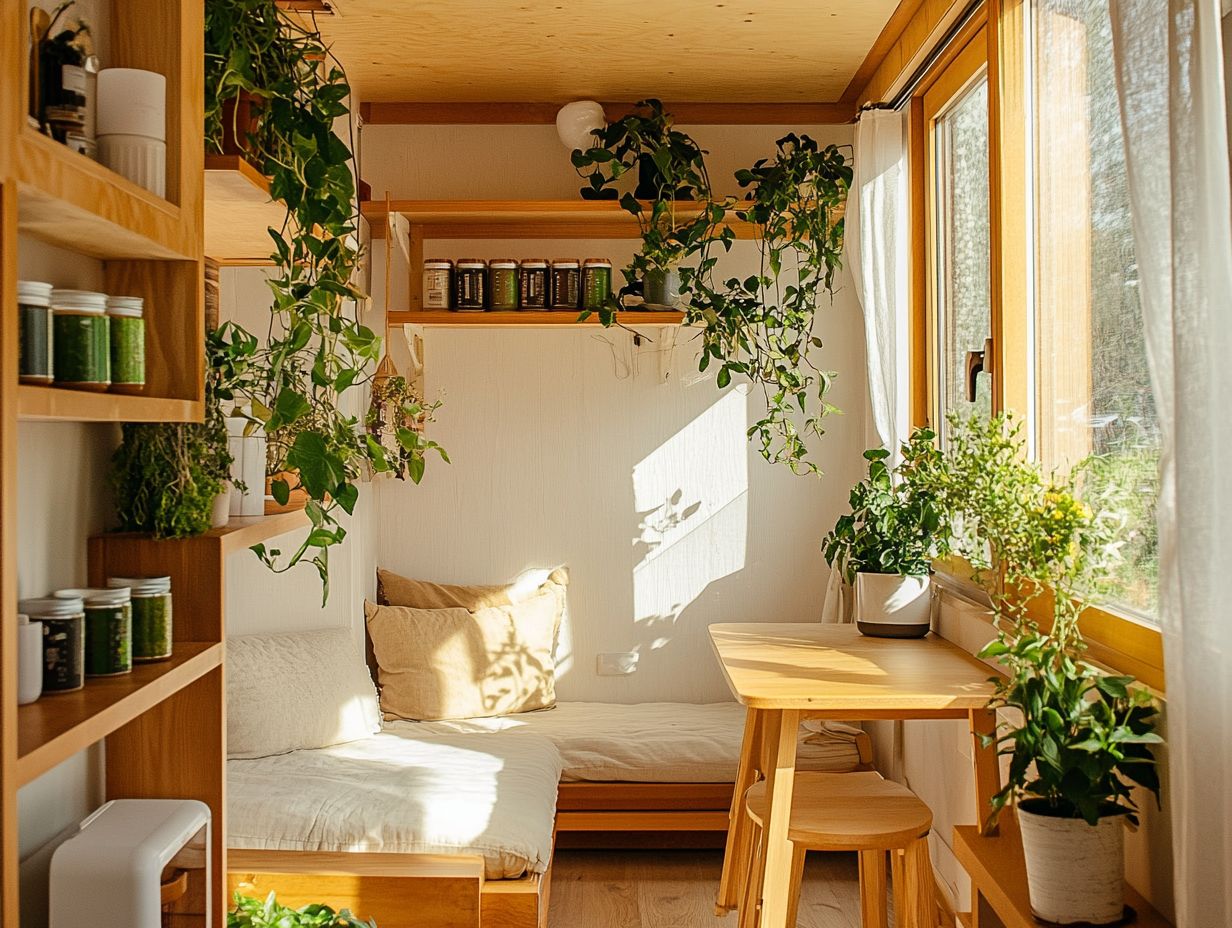
- Eco-friendly paint is made from natural ingredients.
- It has low or zero levels of volatile organic compounds (VOCs), making it safer for both the environment and your health.
- It reduces air pollution and waste during production.
How do I know if a paint is truly eco-friendly?
Look for certifications such as Green Seal, GreenGuard, or EcoLogo. These ensure that the paint has been independently tested and certified as eco-friendly.
You can also check the ingredients list for natural, non-toxic substances like plant oils, resins, and mineral pigments.
Can eco-friendly paint still provide good coverage and color options?
Yes, eco-friendly paint can offer the same coverage and color options as traditional paint. Many eco-friendly paints now come in a variety of finishes, from matte to high gloss.
Plus, they can be mixed to create custom colors!
Do eco-friendly paints cost more than traditional paints?
Eco-friendly paints often cost slightly more than traditional options. Yet, the long-term benefits of using eco-friendly paint, such as improved air quality and health, make it worth the investment.
Are there eco-friendly paint options for different types of surfaces?
Yes, there are eco-friendly paint options for various surfaces like wood, drywall, and concrete. Make sure to choose a paint specifically designed for the surface you’re painting.
This ensures the best outcome for your project.
Can I still achieve a professional finish with eco-friendly paint?
Absolutely! Get ready to impress with a stunning professional finish using eco-friendly paint!
With proper preparation and application techniques, you can achieve incredible results. Just follow the manufacturer’s instructions for the best outcome.

